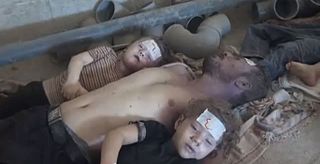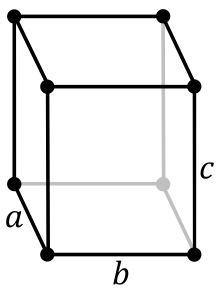
White phosphorus is a material made from a common allotrope of the chemical element phosphorus that is used in smoke, tracer illumination, and incendiary munitions. Other common names include WP and the slang term "Willie Pete" or "Willie Peter" derived from William Peter, the World War II phonetic alphabet for "WP", which is still sometimes used in military jargon. As an incendiary weapon, white phosphorus is pyrophoric (self-igniting), burns fiercely and can ignite cloth, skin, fuel, ammunition, and other combustibles.
Chemical terrorism is the form of terrorism that uses the toxic effects of chemicals to kill, injure, or otherwise adversely affect the interests of its targets. It can broadly be considered a form of Chemical warfare.

A chemical weapon (CW) is a specialized munition that uses chemicals formulated to inflict death or harm on humans. According to the Organisation for the Prohibition of Chemical Weapons (OPCW), "the term chemical weapon may also be applied to any toxic chemical or its precursor that can cause death, injury, temporary incapacitation or sensory irritation through its chemical action. Munitions or other delivery devices designed to deliver chemical weapons, whether filled or unfilled, are also considered weapons themselves."

Human rights violations during the Syrian civil war have been numerous and serious, with United Nations reports stating that the war has been "characterized by a complete lack of adherence to the norms of international law" by the warring parties who have "caused civilians immeasurable suffering".
The use of chemical weapons in the Syrian Civil War has been confirmed by the United Nations. Deadly attacks during the war included the Ghouta attack in the suburbs of Damascus in August 2013 and the Khan al-Assal attack in the suburbs of Aleppo in March 2013. While no party took responsibility for the chemical attacks, the Syrian Ba'athist military was seen as the main suspect, due to a large arsenal of such weapons. A U.N. fact-finding mission and a UNHRC Commission of Inquiry have simultaneously investigated the attacks. The U.N. mission found the likely use of the nerve agent sarin in the case of Khan al-Assal, Saraqib, Ghouta, Jobar and Ashrafiyat Sahnaya. The UNHRC commission later confirmed the use of sarin in the Khan al-Asal, Saraqib and Ghouta attacks, but did not mention the Jobar and the Ashrafiyat Sahnaya attacks. The UNHRC commission also found that the sarin used in the Khan al-Asal attack bore "the same unique hallmarks" as the sarin used in the Ghouta attack and indicated that the perpetrators likely had access to chemicals from the Syrian Army's stockpile. Those attacks prompted the international community to pressure disarmament of the Syrian Armed Forces from chemical weapons, which was executed during 2014. Despite the disarmament process, dozens of incidents with suspected use of chemical weapons followed throughout Syria, mainly blamed on Syrian Ba'athist forces, as well as the Islamic State of Iraq and the Levant and on Syrian opposition forces and Turkish Armed Forces. There have been a number of evidence-gathering processes developed at the international level

The Ghouta chemical attack occurred in Ghouta, Syria during the Syrian Civil War, in the early hours of 21 August 2013. Two opposition-controlled areas in the suburbs around Damascus, Syria were struck by rockets containing the chemical agent sarin. Estimates of the death toll range from at least 281 people to 1,729. The attack was the deadliest use of chemical weapons since the Iran–Iraq War.
The Independent International Commission of Inquiry on the Syrian Arab Republic was set up by the United Nations Human Rights Council on 22 August 2011 to investigate human rights violations during the Syrian Civil War. The Inquiry's Commissioners are Paulo Sérgio Pinheiro, Karen Koning Abuzayd and Hanny Megally and, until August 2017, Carla del Ponte. The Commission posts regular updates via its official Twitter page. The Commission has interviewed more than 6,000 victims and witnesses, produced over 20 reports and prepared several examples of war crimes and crimes against humanity.
The Khan al-Assal chemical attack was a chemical attack in Khan al-Assal, Aleppo, Syria on 19 March 2013, which according to the Syrian Observatory for Human Rights resulted in at least 26 fatalities including 16 government soldiers and 10 civilians, and more than 86 injuries. Immediately after the incident, the Syrian government and opposition accused each other of carrying out the attack, but neither side presented clear documentation. The Syrian government asked the United Nations to investigate the incident, but disputes over the scope of that investigation led to lengthy delays. In the interim, the Syrian government invited Russia to send specialists to investigate the incident. Samples taken at the site led them to conclude that the attack involved the use of sarin, which matched the assessment made by the United States. Russia held the opposition responsible for the attack, while the US held the government responsible. UN investigators finally arrived on the ground in Syria in August, but their arrival coincided with the much larger-scale 2013 Ghouta attacks which took place on 21 August, pushing the Khan al-Assal investigation "onto the backburner" according to a UN spokesman. The UN report, which was completed on 12 December, found "likely use of chemical weapons in Khan al-Assal" and assessed that organophosphate poisoning was the cause of the "mass intoxication".
Syria's chemical weapons program began in the 1970's with weapons and training from Egypt and the Soviet Union, with production of chemical weapons in Syria beginning in the mid-1980's. For some time, Syria was believed to have the world's third-largest stockpile of chemical weapons, after the United States and Russia. Prior to September 2013 Syria had not publicly admitted to possessing chemical weapons, although Western intelligence services believed it to hold one of the world's largest stockpiles. In September 2013, French intelligence put the Syrian stockpile at 1,000 tonnes, including Yperite, VX and "several hundred tonnes of sarin". At the time, Syria was one of a handful of states which had not ratified the Chemical Weapons Convention. In September 2013, Syria joined the CWC, and agreed to the destruction of its weapons, to be supervised by the Organisation for the Prohibition of Chemical Weapons (OPCW), as required by the Convention. A joint OPCW-United Nations mission was established to oversee the destruction process. Syria joined OPCW after international condemnation of the August 2013 Ghouta chemical attack, for which Western states held the Syrian government responsible and agreed to the prompt destruction of its chemical weapons, resulting in U.S. Secretary of State John Kerry declaring on 20 July 2014: "we struck a deal where we got 100 percent of the chemical weapons out." The destruction of Syria's chemical weapons that the Assad government had declared was completed by August 2014, yet further disclosures, incomplete documentation, and allegations of withholding part of Syria's chemical weapons stockpile since mean that serious concerns regarding chemical weapons and related sites in Syria remain. On 5 April 2017, the government of Syria allegedly unleashed a chemical attack that killed 70 civilians. A suspected chemical attack on Douma on 9 April 2018 that killed at least 49 civilians has been blamed on the Syrian Government.

The destruction of Syria's chemical weapons began on 14 September 2013 after Syria entered into several international agreements which called for the elimination of Syria's chemical weapon stockpiles and set a destruction deadline of 30 June 2014. On the same day, Syria acceded to the Chemical Weapons Convention (CWC) and agreed to its provisional application pending its entry into force on 14 October. Having acceded to the CWC, the Organisation for the Prohibition of Chemical Weapons (OPCW) Executive Council on 27 September approved a detailed implementation plan that required Syria to assume responsibility for and follow a timeline for the destruction of Syrian chemical weapons and Syrian chemical weapon production facilities. Following the signing of the Framework Agreement on 14 September 2013 and after the OPCW implementation plan, on 27 September the United Nations Security Council unanimously adopted Resolution 2118 which bound Syria to the timetable set out in the OPCW implementation plan. The joint OPCW-UN mission was established to oversee the implementation of the destruction program.

A barrel bomb is an improvised unguided bomb, sometimes described as a flying IED. They are typically made from a large barrel-shaped metal container that has been filled with high explosives, possibly shrapnel, oil or chemicals as well, and then dropped from a helicopter or airplane. Due to the large amount of explosives, their poor accuracy and indiscriminate use in populated civilian areas, the resulting detonations have been devastating. Critics have characterised them as weapons of terror and illegal under international conventions.
The 2014 Kafr Zita chemical attack occurred on 11 April 2014, in the rebel-held northern Syrian town of Kafr Zita during the Syrian Civil War. The attack reportedly wounded around 100 people and killed three. Syria's state television, SANA blamed the attack on the Islamist Al-Nusra Front using "toxic chlorine", while the opposition blamed barrel bombs dropped by government forces.
The OPCW Fact-Finding Mission in Syria is a mission of the Organisation for the Prohibition of Chemical Weapons (OPCW) to investigate possible use of toxic chemicals, reportedly chlorine, in Syria. The OPCW-Director General Ahmet Üzümcü announced the creation of the mission on 29 April 2014. This initial mission was headed by Malik Ellahi. The Syrian Government agreed to the Mission.
The United Nations Security Council adopted United Nations Security Council resolution 2235 (2015) on 7 August 2015, in response to use of chemical weapons in the Syrian Civil War. The resolution condemned "any use of any toxic chemical, such as chlorine, as a weapon in the Syrian Arab Republic" and expressed determination to identify and hold accountable those responsible for such acts. The resolution established a Joint Investigative Mechanism (JIM), a partnership between the United Nations (UN) and the Organisation for the Prohibition of Chemical Weapons (OPCW). The Security Council renewed the JIM's mandate in resolution 2319 (2016) on 17 November 2016, for a further period of one year. The mandate of the JIM lapsed in November 2017, after Russia blocked the renewal of its mandate.

The United Nations Security Council Resolution 2235 is on establishing a Joint Investigative Mechanism to identify individuals, entities, groups, or governments responsible for use of chemical weapons in the Syrian civil war.

The Khan Shaykhun chemical attack took place on 4 April 2017 on the town of Khan Shaykhun in the Idlib Governorate of Syria.
During the Syrian Civil War, Russian and Syrian government forces have allegedly conducted a campaign that has focused on the destruction of hospitals and medical facilities within areas not under the control of the Syrian government. Russian and Syrian officials have repeatedly denied deliberately targeting medical facilities.

The Sarmin chemical attack was a chlorine attack that took place on 16 March 2015, in the village of Sarmin in the Idlib Governorate of Syria.

On 7 April 2018, a chemical attack in the Syrian city of Douma reportedly killed at least 70 people. It was unclear what chemical had been used. Medics on the ground reported smelling a chlorine-like substance, but said the patients' symptoms and the large death toll pointed to a more noxious substance such as nerve agent sarin. The attack was attributed to the Syrian Army by rebel forces in Douma, non-governmental aid and medical workers there, and by a number of countries, including the United States, most NATO members, and the European Union. Syria and Russia's defense ministries stated that "the attack did not happen and video evidence for it was staged and directed by British intelligence".













